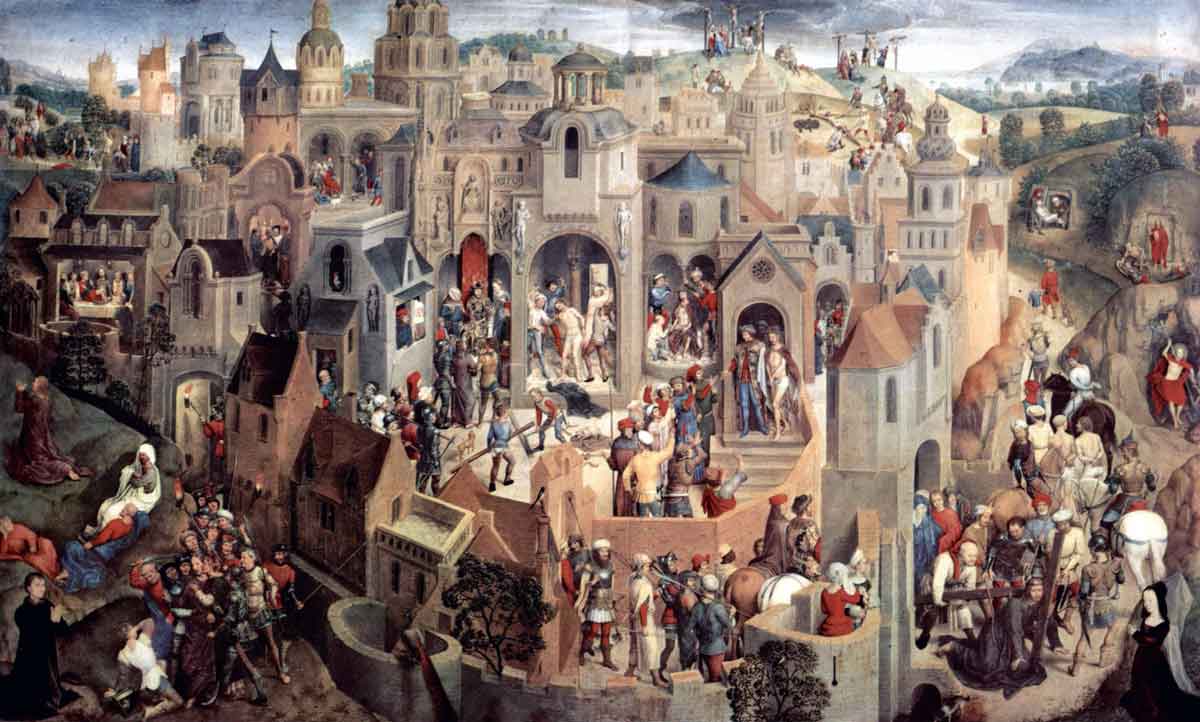+ A.M.D.G. +

THE WAY OF THE CROSS
It is said that the Way of the Cross owes its origin to the Mother of God.
Tradition says that the Blessed Mother of God was wont often to walk in the steps of her Son to Calvary, pausing at the spots marked by some special incident. The early Christians nocked in crowds to the holy places to follow the Via Crucis. But when, in the Middle Ages, the Holy Land fell into the hands of the infidels, and the devout pilgrim could only visit the scenes of Our Lord’s sufferings at the risk of his life, the stations were erected in churches, and enriched by the Popes with large indulgences. St. Francis of Assisi contributed greatly to spread this devotion.
1. The Way of the Cross is the name given to the fourteen stations which depict the way along which Our Redeemer passed, bearing His cross, from Pilate’s palace to Mount Calvary.
The fourteen stations consist of fourteen wooden crosses, to which pictures and inscriptions are generally added. They are erected in churches, sometimes in the open air, on the slope of a hill; occasion ally in cemeteries.
2. The manner of performing the Way of the Cross is to go from one station to another, making meanwhile a meditation on Our Lord’s Passion.
It is not necessary to go from station to station in the church if one stands up and kneels down as every station is being made. It is enough to meditate on the Passion in general, without making a special meditation at each station. An Our Father, Hail Mary, and an act of contrition are generally recited at every one.
3. By performing the Way of the Cross large indulgences may be gained; we also obtain contrition for sin and are in cited to the practice of virtue.
Daily meditation on the Passion of Christ is more profitable than fasting every Friday in the year on bread and water, or taking the discipline to blood. A single tear shed in compassion for Our Lord’s sufferings is of greater value in God’s sight than a pilgrimage to the Holy Land. We learn how acceptable meditation on His Passion is to Our Lord, from the revelations of St. Bridget. Our Lord once appeared to her, with blood streaming from all His wounds. She asked what had reduced Him to this pitiable condition? He answered: “It is the doing of those who never consider the great love I manifested towards them by all I suffered upon the cross.” It was as a continual memorial of His Passion that Our Lord instituted the holy sacrifice of the Mass. The same indulgences are granted for making the Way of the Cross as for visiting the corresponding places in the Holy Land. What the indulgences are we do not know precisely; let us be content to know that they are great and numerous; they can however only be gained once in the day. The wooden crosses must be blessed by a Franciscan, or some priest who has the requisite powers, and the stations must be visited without any break. The Way of the Cross is a means of obtaining the grace of contrition. As the Israelites who were bitten by the fiery serpents were healed by looking upon the brazen serpent, so sinners are healed of the deadly wound of sin by frequent meditation on the Passion of Christ. The Way of the Cross is also an incentive to the practice of virtue. The saints often tell us that meditation on Our Lord’s Passion imparts strength to suffer not merely with patience, but with joy. Our arrogance, our avarice, our anger will be cured by the humility, the poverty, the patience of the Son of God. If, O man, you would progress from virtue to virtue, contemplate with all possible devotion the sufferings of your Lord, for this is most conducive to sanctity.
4. If we are prevented from making the Way of the Cross, we can gain the indulgence by reciting the Our Father, Hail Mary, and the Gloria twenty times, holding meanwhile a crucifix blessed for the stations in our hand.
The hindrances must be of a sufficient nature, such as long distance from a church, sickness, etc. The cross for performing the stations at home must be of strong material, with the figure of the Saviour attached to it, and must have been duly blessed for the purpose. The indulgences are not gained if the crucifix is not the property of the individual using it; but if several persons perform the devotion together, it is enough for one to hold in his hand the cross. For the sick it suffices- to take the cross in the hand and make an act of contrition. The Our Father, Hail Mary and Glory be to the Father are recited fourteen times for the fourteen stations, five times in honor of the five wounds of Our Lord and once for the Holy Father. If the cross has been blessed by a Redemptionist the prayers need only be repeated fourteen times.
« Previous Section
PILGRIMAGESNext Section »
EXPOSITION OF THE MOST HOLY SACRAMENT
This article, THE WAY OF THE CROSS is a post from The Bellarmine Forum.
https://bellarmineforum.org/bf_catechism/the-catechism-explained/part-iii-the-means-of-grace/iv-prayer/the-principal-devotional-exercises/the-way-of-the-cross/
Do not repost the entire article without written permission. Reasonable excerpts may be reposted so long as it is linked to this page.
